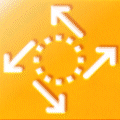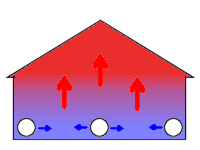
| ||||
W. Tombling Ltd.
Wembley House
Dozens Bank
West Pinchbeck
Spalding
Lincolnshire
PE11 3ND
U.K.


Displacement ventilation with an air duct
Displacement ventilation uses low velocity cool air diffused from an air duct at floor level to replace warmer polluted air. The air duct provides occupants with a continuous supply of fresh, clean air while forcing smoke, fumes and pollution upwards.Displacement ventilation is not new, it was first used in the pyramids by the Egyptians, and has been used in Scandinavia for over 40 years, in large commercial and industrial buildings such as gymnasiums, factories, supermarkets etc.
How displacement ventilation works

Displacement ventilation uses the natural effect that warm air will rise while cool air will sink.
By introducing low velocity cool air from an air duct at floor level a pool of fresh air is created. This air will be slowly heated by the activities of the occupants in building, and will start to rise, taking smoke, fumes and dust particles with it. Eventually the warm air reaches the roof where extractor fans exhaust it from the building.
Using an Activair air duct
An Activair air duct is the most efficient method to distribute the low velocity cool air at floor level. Very small holes in the side of the air duct, create a series of low velocity jets, which gently diffuse the air. The air duct can be positioned under benches or racking and combined with metal elbows and tee-pieces to ensure the cool air is spread evenly throughout the building.The Activair air duct system costs upto 80% less than equivalent fabric, or textile ducts, and is the most economical, flexible and adaptable method of cold air distribution.
Advantages of displacement ventilation
Displacement ventilation works well where smoke, fumes or dust build up. It provides draft free ventilation, while delivering clean fresh air to the building occupants. It uses less fresh air than conventional ventilation, leading to savings in:
Treating incoming air - the volume of air required is less, so the cost of heating or cooling it is proportionally smaller
Smaller ventilation equipment - smaller, less costly fans, heaters, air handling units, air duct, etc.
Slow air movement - dust particles are carried away, rather than being blown around.
Buildings suited to displacement ventilation
Displacement ventilation improves the environment of buildings suffering from poor indoor air quality or sick building syndrome. It is particularly suited to buildings that:
Require high rates of air change - to remove fumes, smoke or other pollutants
Are high occupancy - to remove naturally occurring byproducts of breathing and smoking
Have high ceilings - Because displacement ventilation relies on the natural effect of stratification it works best in buildings with ceilings higher than 4m (13ft.)
Have dusty environments - where dust must be removed and not spread i.e. paint shops
Have processes that generate a lot of heat - The heat can be used to aid ventilation
For more information on Activair air ducts
An Activair air duct can be used to provide low velocity air distribution in displacement ventilation systems. 10 diameters of air duct are available to suit most applications.For further information on the Activair air duct system or a quotation see:
The benefits of Activair air ducts
Layflat ducting - sizes and quotations
If you found this page useful, please take a moment
to tell a friend or colleague about it.
Copyright © 2003/6, W. Tombling Ltd.